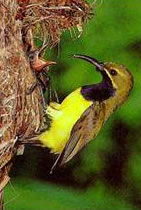

Marungu Sunbird
|
Creature Profile
The Marungu sunbird is only found in the Marungu highlands of southeastern Zaire which are situated to the west of the southern
half of Lake Tanganyika. It is a very small bird, similar in size to the hummingbird with a long down-curved bill. Although they are completely
unrelated, sunbirds behave very much like hummingbirds. Their flight is fast and direct on their short wings, and although they prefer feeding
while perched, many sunbird species
can take nectar by hovering over plants.
This species is only found in a remnant riparian forest covering only a small part of the Marungu Highlands. It is believed that the species
depends on this forest for its survival. Little is known about the behavior of this species. All sunbird species feed largely on nectar, although
they will also feed on insects, especially when feeding their young. Most sunbirds are sedentary and are known to migrate short distances as the seasons
change. Like hummingbirds, the males are usually much brighter and more brilliant in color. This species may lay two to three eggs in a purse-shaped
suspended nest.
This species is threatened by loss of habitat due to logging, and the site where it is found is used extensively for cattle-raising, resulting in
erosion of stream banks caused by overgrazing. To ensure protection for this species in the future, conservationists have proposed that forests found
nearby be established as protected conservation areas.
April 27, 2007
Glenn, C. R. 2006. "Earth's Endangered Creatures - Marungu Sunbird Facts" (Online). Accessed 4/24/2024 at http://earthsendangered.com/profile.asp?sp=436&ID=1.
Need more Marungu Sunbird facts?



